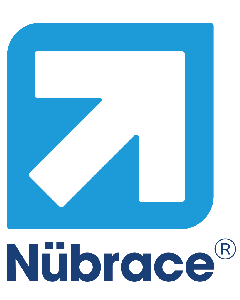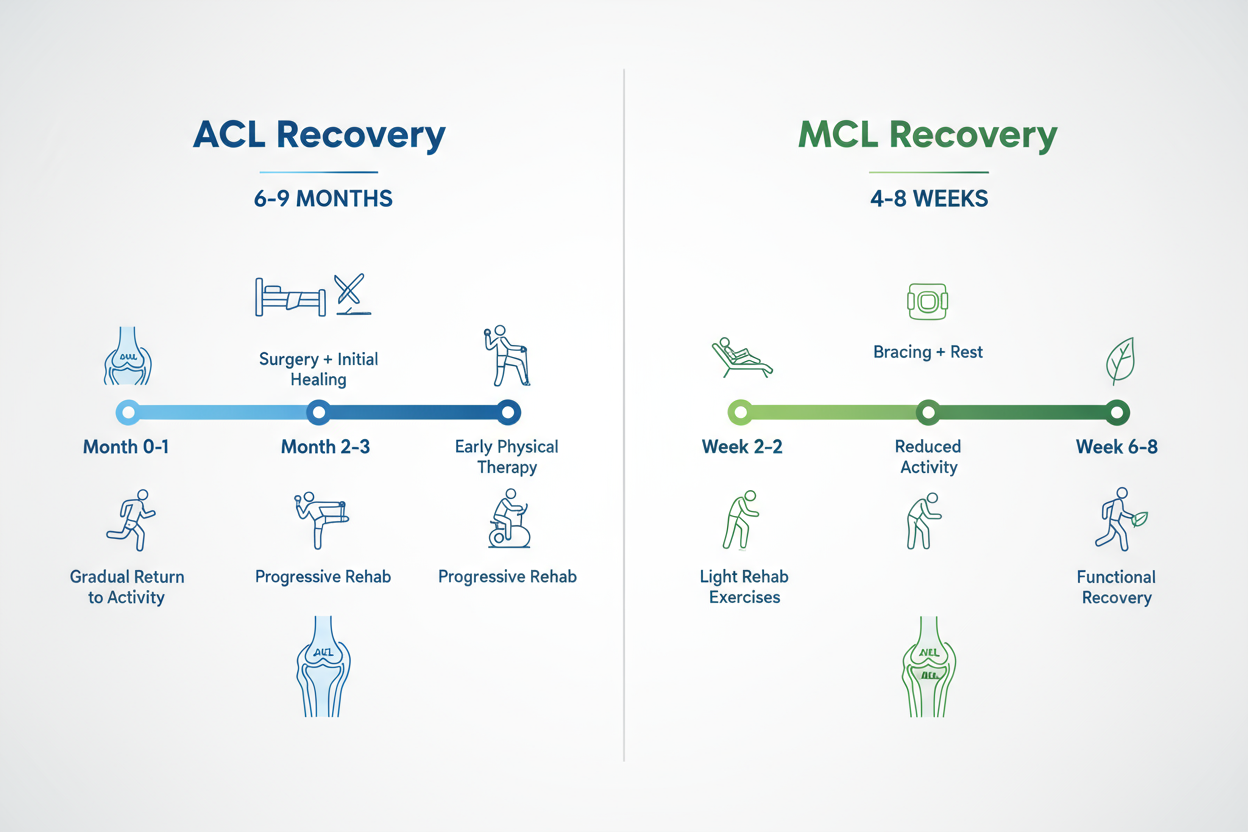Recovery from an ACL or MCL tear typically takes 6 to 9 months, depending on the severity of the injury, the treatment approach (surgical or non-surgical), and the individual’s commitment to rehabilitation. Mild sprains may heal in 6–8 weeks, while full tears requiring surgery can take up to a year. Using an ACL brace for sports or ACL knee support during recovery is essential for stability, joint protection, and a safe return to physical activity.
Understanding ACL and MCL Injuries
The ACL (Anterior Cruciate Ligament) and MCL (Medial Collateral Ligament) are two of the main ligaments that stabilize your knee.
- The ACL prevents the shinbone from sliding forward and supports twisting movements.
- The MCL stabilizes the inner side of the knee and prevents it from bending inward.
Injuries to these ligaments often occur during high impact sports such as football, basketball, soccer, or skiing, especially during sudden stops, pivots, or awkward landings. The severity of the tear determines how long recovery will take and whether surgery is necessary.
Typical Recovery Timelines
The recovery process for ACL and MCL injuries varies by injury grade and treatment type. Below is an overview of the general timeline for both ligaments:
1. Minor (Grade 1) Sprain:
- Recovery time: 4-6 weeks
- Treatment: Rest, ice, compression, elevation (RICE) and physical therapy
- Support: A light ACL knee support or compression sleeve helps reduce swelling and maintain stability
2. Partial (Grade 2) Tear:
- Recovery time: 2-3 months
- Treatment: Physical therapy, bracing, and gradual strengthening
- Support: A hinged ACL brace for sports helps protect the joint from side to side movement
3. Complete (Grade 3) Tear:
- Recovery time: 6-12 months (often requires surgery)
- Treatment: Surgical reconstruction of the ligament followed by extensive physical therapy
- Support: Rigid ACL braces are used post surgery to stabilize and protect the knee during rehabilitation
Recovery Stages After ACL or MCL Injury
Stage 1: Initial Rest and Protection (First 1-2 Weeks)
Right after the injury or surgery, the focus is on pain control and inflammation reduction.
- Rest and avoid putting weight on the injured leg.
- Apply ice packs for 15-20 minutes several times a day.
- Use crutches if needed to prevent stress on the joint.
- Wear a knee support or ACL brace to immobilize and protect the area.
This stage lays the groundwork for proper healing and prevents further damage.
Stage 2: Early Rehabilitation (Weeks 2-6)
As swelling decreases, gentle motion and muscle activation become priorities.
- Begin basic range of motion exercises under medical supervision.
- Strengthen surrounding muscles like the quadriceps and hamstrings.
- Continue using an ACL knee support for stability and to prevent overextension.
For partial tears, patients may start light weight bearing activities by the end of this phase.
Stage 3: Intermediate Strengthening (Weeks 6-12)
- Progress to more challenging strengthening and balance exercises.
- Incorporate light cardio, such as cycling or swimming.
- Use an ACL brace for sports during training sessions to protect the healing ligament.
- Maintain a focus on controlled, low impact movements.
Consistency with physiotherapy is crucial at this stage to prevent stiffness and build joint stability.
Stage 4: Advanced Rehabilitation (3-6 Months)
This stage prepares the knee for more dynamic movements and functional activities.
- Begin sport specific drills (under supervision).
- Continue progressive strength and agility training.
- Use an ACL knee support or ACL brace for sports during all physical activity to prevent re injury.
If you’ve undergone surgery, your doctor will evaluate ligament stability before approving any return to sport or heavy training.
Stage 5: Return to Sports and Long-Term Maintenance (6-12 Months)
A gradual return to sports begins once the knee is fully stable and strength is restored.
- Regularly wear ACL braces or supports during games or training.
- Focus on flexibility, balance, and proprioception exercises to maintain control.
- Keep strengthening the muscles that support the knee.
Even after recovery, athletes are encouraged to continue using an ACL knee support during high intensity activities to minimize re injury risk.
The Role of an ACL Brace for Sports
An ACL brace for sports provides critical protection throughout recovery and beyond. Here’s how it helps:
- Prevents excessive knee movement: Keeps the joint stable during pivoting, cutting, and landing.
- Reduces pain and swelling: Compression improves circulation and helps manage inflammation.
- Supports confidence: Many athletes feel safer and more stable with a knee brace, allowing them to focus on movement rather than fear of re-injury.
There are various ACL braces, including:
- Hinged braces: Offer rigid protection after surgery.
- Compression sleeves: Provide mild support during early healing or light activity.
- Custom fitted braces: Designed for athletes returning to sports requiring agility and quick direction changes.
Your physician or physiotherapist can recommend the most suitable ACL knee support based on your activity level and stage of recovery.
Factors Affecting Recovery Time
Every person’s recovery timeline is unique. The following factors influence how quickly and successfully you can return to full function:
- Severity of the tear: Full tears take longer than minor sprains.
- Surgical vs. non surgical treatment: Reconstruction surgery extends recovery but offers greater long-term stability.
- Physical therapy commitment: Consistent exercise and adherence to your program accelerate healing.
- Use of ACL braces: Proper bracing protects the joint and allows controlled movement during recovery.
- Age and fitness: Younger and fitter individuals generally heal faster.
Tips for a Successful ACL/MCL Recovery
- Follow medical advice: Stick to your doctor’s and therapist’s instructions.
- Stay consistent: Regular therapy and daily exercises speed up recovery.
- Eat a balanced diet: Nutrients like protein, collagen, and vitamin C help tissue repair.
- Don’t rush: Returning to sports too soon can lead to re-injury.
- Use your ACL brace: Even when you feel strong, continue wearing support during sports or high impact movements.
When to Seek Medical Help
Contact your doctor or physiotherapist if you notice:
- Increasing pain or swelling after activity
- Knee instability or locking
- A “popping” sound or feeling of giving way
- Redness, warmth, or drainage after surgery
Early intervention prevents complications and ensures a smoother recovery.
Conclusion
Recovering from an ACL or MCL tear takes 6 to 9 months on average, though the timeline varies by injury type and treatment. Consistent rehabilitation, proper rest, and the use of an ACL knee support are key to achieving a full recovery. By following a structured plan and protecting your knee during physical activity, you can safely return to the sports and movements you love stronger and more resilient than before.









